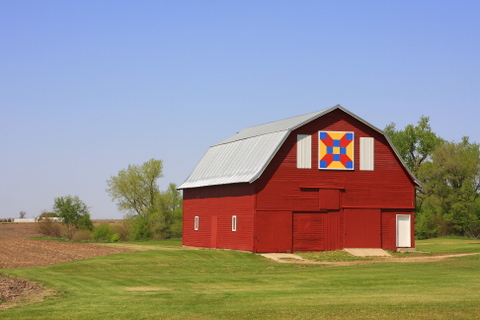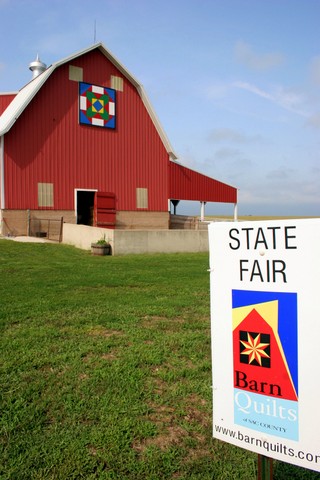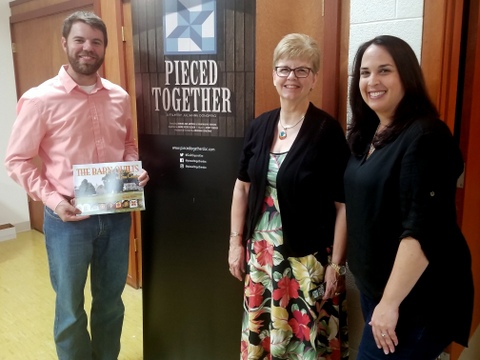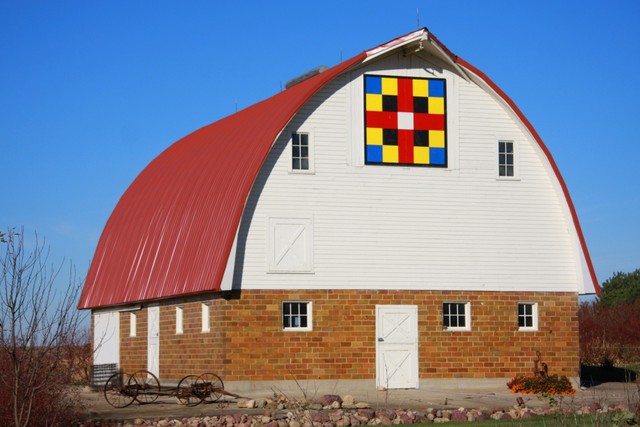
Pieced Together: Barn Quilt Documentary Features Iowa Stories
Barn quilts have become a folk-art phenomenon in Iowa in the past 15 years, turning up not only on barns, but mailboxes, gardens, buildings in town and more. But there was a time not that long ago when no one had ever heard of a barn quilt—not until Donna Sue Groves wanted to add a little color to her corner of the world.
Her story—and those of barn quilt enthusiasts in places like Sac County—inspired the 53-minute documentary “Pieced Together,” which filmmaker Julianne Donofrio showed in Sac City to a full house at the First Christian Church on the evening of Sept. 24, 2018.
“A lot of people don’t know where barn quilts came from,” said Donofrio, who is from the New York City/Washington, D.C. area. “I want people to know Donna Sue’s story.”
The story, which includes many barn quilts across Iowa, began in 1989 when Groves’ family bought a farm in Adams County, Ohio, near the Ohio River Valley at the foothills of the Appalachian Mountains. Groves made a casual remark to her mother, Nina Maxine Groves, about an uninspiring, time-worn tobacco barn on the farm.
“It was the ugliest barn I’d ever seen,” Groves said in “Pieced Together.” “I joked to my mother, ‘I’ll paint you a quilt square on it someday.’”
Game inspires a lifelong love of barns
Groves’ interest in barns dates back to her childhood. When her family would visit Groves’ grandmother in Roane County, West Virginia, Groves’ mother invented a car game to keep Groves and her brother quiet.
“You couldn’t play the typical license plate game when you’re traveling the back roads of West Virginia, because all you saw were West Virginia license plates,” Groves said. “Mother created a car game where we counted barns.”
Some barns were worth two points, while others were worth three points. If a barn had outdoor advertising, like “Chew Mail Pouch” or “RC Cola,” players got a 10-point bonus if they could read the lettering. Red barns also earned higher points. The chance to earn even more points awaited when the family’s wider travels took them past Pennsylvania Dutch barns with colorful, geometric hex signs.
The game led to discussions and questions about the barns, such as who built the barns, and for what purpose. Groves enjoyed these conversational teaching moments. “I looked forward to seeing barns,” she said.

Sac County Iowa barn quilt
Creating a clothesline of quilts across America
This history eventually inspired Groves’ involvement with the first barn quilt square, an Ohio Star pattern, which was created in October 2001 and displayed in Adams County, Ohio. This small gesture triggered a ripple effect across North America.
“If we didn’t pick up on this idea, someone else would,” said Groves’ mother, Maxine, who was featured in “Pieced Together.”
As more people wanted to create barn quilts, Groves and her fellow volunteers quickly learned that painting barn quilts directly onto barns didn’t work too well, but painted plywood squares offered a much better option.
Why stop with just a few barn quilts, though? “A trail of barn quilts could bring tourists here to see all the wonderful things Adams County offers,” noted Groves, who has served as a field representative for the Ohio Arts Council. “Then they’d stay in our bed-and-breakfasts and motels and eat at our restaurants.”
These opportunities for economic development, combined with the visual appeal of barn quilts, soon inspired a “clothesline of quilts” across America. Residents of an adjoining county, Brown County, Ohio, loved Groves’ idea and asked how to get involved. Folks in Tennessee read an article about the Ohio barn quilt project, called Groves and wanted to know how to do a similar project in their area. Grundy County, Iowa, also got involved in 2003, followed by Sac County.
When Sue Peyton and her family from rural Sac City heard about barn quilts, it seemed like a good fit for her son, Kevin, who was in high school and looking for a project he could use as a 4-H leadership project and a Herbert Hoover Uncommon Student Award project.
“I immediately fell in love with the project when I heard about it,” Sue Peyton said. “Barns and barn quilts are such a natural fit.”
The Peytons coordinated the construction and painting of Sac County’s first barn quilts in the summer of 2005. While some people weren’t quite sure what to make of the new barn quilts that started appearing on barns and corncribs around the county, the concept caught on quickly. “We hoped to get 20 barn quilts,” said Sue Peyton, who added that Sac County boasted 55 barn quilts within two years of the start of the project.
“I’ve seen a lot of quilt trails, and you embraced this early on and have done a tremendous job,” said Donofrio as she chatted with audience members in Sac City following her documentary.

Sac County barn quilt proponents Kevin Peyton and his mother, Sue, (center) welcomed filmmaker Julianne Donofrio, who showed her 53-minute documentary “Pieced Together” in Sac City to a full house at the First Christian Church in September 2018.
“We’re here to stay”
Anywhere there’s a barn quilt trail, every square tells a story. Also, there’s no right or wrong way to create a barn quilt. “Barn quilts have a storied history as complex and diverse as the quilt patterns themselves,” Kevin Peyton said.
Consider the Double Aster barn quilt pattern on the Hogue family’s 1943 barn north of Odebolt. The pastel-colored design complements the family’s Prairie Pedlar Gardens business. Owner Jane Hogue, who served on the original Sac County Barn Quilt Committee, enjoyed watching the “Pieced Together” documentary.
“It was fun to see the snippets of Sac County’s barn quilts in the film,” she said. “We’re proud to be part of Sac County’s barn quilt project. With our gardens and tourism, it’s a win-win.”
Sac County proves that barn quilts offer an effective way to help save barns, promote rural tourism and boost economic development, Sue Peyton added. She cited the vintage barn at the Rustic River Winery and Vineyard north of Lake View, for example. It has been remodeled not only into a winery, but a venue where people can host parties and other gatherings.
As the history of the barn quilt phenomenon is preserved through projects like “Pieced Together,” barn quilts are being praised as one of the greatest community art projects ever created. While there are barn quilt trails in 42 states, there is no national barn quilt organization, by design. Creating barn quilts at the local allows local people to make their mark, share their history and establish a legacy. “It’s so adaptable—that’s the beauty of it,” Groves said.
Above all, barn quilts inspire people to view rural communities in a new way. “Barn quilts prompt a question that starts a discussion,” noted a speaker in the “Pieced Together” documentary. “It’s a statement that, ‘We’re here, and we’re here to stay.’”
Barn quilts also prove the power of one person from an isolated rural county to inspire a vision that has touched an entire nation. “As times get harder, we forget how to dream,” said Groves, a cancer survivor. “I like to think the barn quilt trails allow people to dream.”

Sac County barn quilt near Early, Iowa
Want more?
Thanks for stopping by. I invite you to read more of my blog posts if you value intriguing Iowa stories and history, along with Iowa food, agriculture updates, recipes and tips to make you a better communicator.
If you like what you see and want to be notified when I post new stories, be sure to click on the “subscribe to blog updates/newsletter” button at the top of this page, or click here. Feel free to share this with friends and colleagues who might be interested, too.
Also, if you or someone you know could use my writing services (I’m not only Iowa’s storyteller, but a professionally-trained journalist with 20 years of experience), let’s talk. I work with businesses and organizations within Iowa and across the country to unleash the power of great storytelling to define their brand and connect with their audience through clear, compelling blog posts, articles, news releases, feature stories, newsletter articles, social media, video scripts, and photography. Learn more at www.darcymaulsby.com, or e-mail me at yettergirl@yahoo.com.
If you’re hungry for more stories of Iowa history, check out my top-selling “Culinary History of Iowa: Sweet Corn, Pork Tenderloins, Maid-Rites and More” book from The History Press. Also take a look at my latest book, “Dallas County,” and my Calhoun County” book from Arcadia Publishing. Both are filled with vintage photos and compelling stories that showcase he history of small-town and rural Iowa. Order your signed copies today! Iowa postcards are available in my online store, too.
Let’s stay in touch. I’m at darcy@darcymaulsby.com, and yettergirl@yahoo.com.
Talk to you soon!
Darcy
@Copyright 2018 Darcy Maulsby & Co. Blog posts may only be reprinted with permission from Darcy Maulsby.
2 responses to “Pieced Together: Barn Quilt Documentary Features Iowa Stories”
Recent Posts
- Do Press Releases Still Work?
- Erasing History? Budget Cuts Threaten to Gut Ag History at Iowa State University
- Machines that Changed America: John Froelich Invents the First Tractor in Iowa
- Bob Feller on Farming, Baseball and Military Service
- Classic Restaurants of Des Moines: A Taste of Thailand Served the "Publics" and Politics
- Want to Combat Fake News? Become a Better Researcher
Categories
- Achitecture
- Agriculture
- Architecture
- baking
- barbeque
- Barn
- breakfast
- Business
- Communication Tips
- Conservation
- content
- cooking
- Crime
- Dallas County
- Economical
- Farm
- Featured
- Food
- Food history
- health
- Iowa
- Iowa food
- Iowa history
- marketing
- Photography
- Recipes
- Seasonal
- Small town
- Storytelling
- Uncategorized
- writing
Archive by year
- 2023
- 2022
- 2021
- 2020
- When Agriculture Entered the Long Depression in the Early 1920s
- The Corn Lady: Jessie Field Shambaugh and the Birth of 4-H in Iowa
- Sauce to Sanitizer: Cookies Food Products Bottles Hand Sanitizer Made with Ethanol
- Myth Busting: No, Your Pork Doesn't Come from China
- Long Live Print Newsletters! 5 Keys to Content Marketing Success
- Shattering Silence: Farmer Helped Slave Find Freedom and Racial Equality in Iowa
- Meet Iowa Farmer James Jordan, Underground Railroad Conductor
- George Washington Carver Rose from Slavery to Ag Scientist
- Remembering the African-American Sioux City Ghosts Fast-Pitch Softball Team
- Want to Combat Fake News? Become a Better Researcher
- Classic Restaurants of Des Moines: A Taste of Thailand Served the "Publics" and Politics
- 2019
- The Untold Story of Iowa’s Ag Drainage Systems
- Stop Rumors Before They Ruin Your Brand
- Finding Your Voice: The Story You Never Knew About "I Have a Dream"
- Warm Up with Homemade Macaroni and Cheese Soup
- Can a True Story Well Told Turn You into a Tom Brady Fan?
- Baking is for Sharing: Best Bread, Grandma Ruby’s Cookies and Other Iowa Favorites
- 4 Key Lessons from Bud Light’s Super Bowl Corn-troversy
- Could Your Story Change Someone’s Life?
- What To Do When the Travel Channel Calls
- Tex-Mex Sloppy Joes and the Magic of Maid-Rite in Iowa
- How Not to Invite Someone to Your Next Event--and 3 Solutions
- We Need FFA: Iowa Ag Secretary Mike Naig Reflects on His FFA Experiences
- From My Kitchen to Yours: Comfort Food, Conversation and Living History Farms
- Smart Marketing Lessons from an Uber Driver--Listen Up!
- Hog Trailers to Humidors: Two New Iowa Convenience Stores Reflect “Waspy’s Way”
- A Dirty Tip to Make Your Social Media Content More Shareable
- Are You on Team Cinnamon Roll?
- Senator Grassley on Farming: Any Society is Only Nine Meals Away From a Revolution
- Why We Should Never Stop Asking Why
- What’s the Scoop? Expanded Wells’ Ice Cream Parlor Offers a Taste of Iowa
- Independence, Iowa’s Connection to the Titanic and Carpathia
- Memories of Carroll County, Iowa, Century Farm Endure
- Iowa's “Peacemaker Pig” Floyd of Rosedale Helped Calm Racial Tensions
- 2018
- How to Cook a Perfect Prime Rib
- How Did We Get So Rude?
- Mmm, Mmm Good: Soup’s on at the Rockwell City Fire Department
- Quit Using “Stupid Language”
- In Praise of Ham and Bean Soup
- Recalling a Most Unconventional—and Life-Changing--FFA Journey
- Events Spark Stories That Help Backcountry Winery Grow in Iowa
- Sac County Barn Quilt Attracts National Attention
- Doing Good, Eating Good at Lytton Town Night
- Young Entrepreneur Grows a Healthy Business in Small-Town Iowa
- Digging Deeper: Volunteers Showcase Thomas Jefferson Gardens in Iowa
- How to Tell Your Community’s Story—with Style!
- DNA Helps Sailor Killed at Pearl Harbor Return to His Family
- It’s Time to Be 20 Again: Take a Road Trip on Historic Highway 20
- The Biggest Reason You Shouldn’t Slash Your Marketing Budget in Tough Times
- Are You Telling a Horror Story of Your Business?
- Pieced Together: Barn Quilt Documentary Features Iowa Stories
- Unwrapping Storytelling Tips from the Candy Bomber
- Barn Helped Inspire Master Craftsman to Create Dobson Pipe Organ Builders
- Butter Sculptures to Christmas Ornaments: Waterloo Boy Tractor Celebrates 100 Years
- Ag-Vocating Worldwide: Top 10 Tips for Sharing Ag’s Story with Consumers
- 2017
- Growing with Grow: Iowa 4-H Leader Guides 100-Year-Old 4-H Club for 50 Years
- High-Octane Achiever: Ethanol Fuels New Driver Tiffany Poen
- Shakespeare Club Maintains 123 Years of Good Taste in Small-Town Iowa
- Iowa’s Ice Queen: Entrepreneur Caroline Fischer’s Legacy Endures at Hotel Julien Dubuque
- Darcy's Bill of Assertive Rights: How to Communicate and Get What You Need
- Celebrating Pi Day in Iowa with Old-Fashioned Chicken Pot Pie
- Cooking with Iowa’s Radio Homemakers
- Top 10 Tips to Find the Right Writer to Tell Your Company’s Stories
- The “No BS” Way to Protect Yourself from Rude, Obnoxious People
- Learning from the Land: 9 Surprising Ways Farmers Make Conservation a Priority
- Leftover Ham? Make This Amazing Crustless Spinach and Ham Quiche
- Iowa’s Lost History from the Titanic
- Coming Soon--"Dallas County," a New Iowa History Book!
- How to Clean a Burned Pan in 6 Simple Steps
- Iowa Beef Booster: Larry Irwin Takes a New Twist on Burgers
- Get Your Grill On: How to Build a Better Burger
- "Thank God It’s Over:" Iowa Veteran Recalls the Final Days of World War 2
- How to Thank Veterans for Their Military Service
- Imagine That! Writers, Put Your Reader Right in the Action
- Remembering Ambassador Branstad’s Legacy from the 1980s Farm Crisis in Iowa
- Busting the Iowa Butter Gang
- Lightner on Leadership: “Everyone Has Something to Give”
- Show Up, Speak Up, Don’t Give Up
- Small - Town Iowa Polo Teams Thrilled Depression - Era Crowd
- Ethanol:Passion by the Gallon
- Cruising Through Forgotten Iowa History on Lincoln Highway
- Why I'm Using a Powerful 500-Year-Old Technology to Make History--And You Can, Too
- 5 Ways a “History Head” Mindset Helps You Think Big
- Behind the Scene at Iowa's Own Market to Market
- Let’s Have an Iowa Potluck with a Side of History!
- Iconic State Fair Architecture: Historic Buildings Reflect Decades of Memories
- Iconic State Fair Architecture- Historic Buildings Reflect Decades of Memories
- Iowa Underground - How Coal Mining Fueled Dallas County's Growth
- Ultra-Local Eating: Jennifer Miller Guides CSA, Iowa Food Cooperative
- The Hotel Pattee and I are Hosting a Party—And You’re Invited!
- Tell Your Story—But How?
- Mediterranean Delights: Iowa Ag Influences Syrian-Lebanese Church Dinner
- 6 Steps for More Effective and Less Confrontational Conversations
- 6 Steps for More Effective and Less Confrontational Conversations!
- 6 Ways to Motivate Yourself to Write—Even When You’re Not in the Mood
- Always Alert-How to Stay Safe in Any Situation
- Does Accuracy Even Matter Anymore?
- Soy Power Shines at Historic Rainbow Bridge
- Free Gifts! (Let’s Talk Listening, Stories and History)
- 2016
- How to Connect with Anyone: Lessons from a Tornado
- Soul Food: Lenten Luncheons Carry on 45-Year Iowa Tradition
- Top 3 Tips for Writing a Must-Read Article
- Darcy's Top 10 Tips to Better Writing
- Top 8 Tips for Building a Successful Freelance Business
- 10 Steps to Better Photos
- Reinventing the Marketer of 2010
- Extreme Writing Makeover
- My Top Social Media Tips for Farmers: REVEALED!
- Honoring the Legacy of Rural Iowa's Greatest Generation
- Iowa's Orphan Train Heritage
- Dedham’s Famous Bologna Turns 100: Kitt Family Offers a Taste of Iowa History
- Iowa Barn Honors Pioneer Stock Farm
- Darcy's Top 10 Tips for Better Photos
- Soup and Small-Town Iowa Spirit
- Savoring the Memories: Van's Café Served Up Comfort Food for Six Decades
- Mayday, Mayday—The Lost History of May Poles and May Baskets in Iowa
- Iowa's Vigilante Crime Fighters of the 1920s and 1930s
- Very Veggie: Iowan's Farm-Fresh Recipes Offer Guilt-Free Eating
- Iowa Public TV's "Market to Market" Features Expedition Yetter, Agri-Tourism, Des Moines Water Works' Lawsuit
- 62 Years and Counting: Calhoun County, Iowa, Families Maintain 4th of July Picnic Tradition
- “A Culinary History of Iowa” Satisfies: Iowa History Journal Book Review
- For the Love of Baking: Lake City's Ellis Family Showcases Favorite Iowa Farm Recipes (Caramel Rolls, Pumpkin Bars and More!)
- Remembering Sept. 11: Iowa Community’s Potluck Honors America
- Talking Iowa Food and Culinary History on Iowa Public Radio
- Talking "Stilettos in the Cornfield," Taxes, Trade and More on CNBC
- FarmHer #RootedinAg Spotlight--FFA Attracts More Women to Careers in Ag
- Rustic Cooking Refined: Iowan Robin Qualy Embraces Global Flavors
- Voice of Reason: Iowa Pork Producer Dave Struthers Offers Top 10 Tips to Speak Up for Ag
- Iowa Eats! Why Radio Iowa, Newspapers and Libraries are Hungry for "A Culinary History of Iowa"
- Iowa Turkeys Carry on National Thanksgiving Tradition
- Riding with Harry: 2016 Presidential Election Reflects Truman's Iowa Revival at 1948 Plowing Match in Dexter
- All Aboard! Rockwell City’s “Depot People” Offer a Taste of Iowa History
- Is This Iowa's Favorite Appetizer?
- O, Christmas Tree! Small Iowa Towns Celebrate with Trees in the Middle of the Street
- Slaves Escaped Through Dallas County on Iowa’s Underground Railroad
- Adel Barn Accents Penoach Winery in Iowa
- Celebrating New Year's Eve in Style at a Classic Iowa Ballroom

Love the story and love seeing the barn quilts when we travel across Iowa! Thanks for sharing!
Thanks so much, Linda. Glad you enjoyed the story, and enjoy your travels across Iowa!